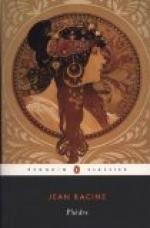|
This section contains 1,094 words (approx. 4 pages at 300 words per page) |

|
Neoclassical Version of Phaedra's Love for Hippolytus
Summary: An analysis of how French neoclassicism influenced Jean Racine's retelling of the classic greek myth of Hippolytus. Racine recast the story to met the rules set by the French Academy for drama. Compares Racine's version with the classic version by Euripides.
Art imitates life. The ancient Greek myths of the gods of mount Olympus have been retold many times by many play writes over the years. Though the same basic story, each version is always different. Each author who retells it has different life experiences that influence his interpretation in different ways. Jean Racine lived in France in the neoclassical period when The French Academy set out firm rules for what drama should be. Therefore, when he retold the old myth of Phaedra and her doomed love for Hippolytus, he made changes to adhere to The French Academy's rules of Neoclassicism. The most important of the changes he made was changing the basis of the myth. Instead of this being a myth about a goddess's revenge, he made it a myth about a human's love.
In earlier version of the myth, such as Hippolytus by Euripides, the gods play...
|
This section contains 1,094 words (approx. 4 pages at 300 words per page) |

|


